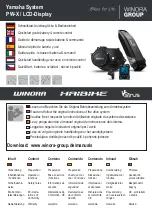
FACELIA N3/ CARLINA N7 Manual
13
3.4
Electric assistance:
3.4.1
Operation:
Your bicycle is an electrically-assisted one: it is equipped with an electric motor, which is located on the front
wheel. This motor starts automatically (if the ignition is on and the battery is charged) when and only when
you are pedalling.
Power assistance is initiated by an electromagnetic detector, which cuts off the motor's power supply as soon
as you stop pedalling.
The motor also stops:
•
When you activate one of the two brakes;
•
When you have reached the speed limit of 25 km/h.
This principle enables the motor to give you its full power when you need it and to save battery power when
you are descending or on flat ground.
This type of energy management gives you a longer battery life per charge. These functions and the energy
man
agement are carried out by an electronic control unit or “controller”.
W
E WOULD LIKE YOU TO NOTE THAT ACTIVATION OR DEACTIVATION OF POWER ASSISTANCE MAY LEAD TO
ABRUPT ACCELERATION OR DECELERATION
.
3.4.2
Performance:
The power-assisted speed of your e-bike is limited to 25 km/h.
At this speed the motor's power supply is automatically cut off.
The battery life per charge of your bike depends on several factors:
❖
Weight transported:
The expected performance of your bike is based on an average load of 75 kg.
❖
External temperature:
The expected performance of your bike is based on an external temperature of roughly 20°C.
Performance decreases below this temperature, but is only really discernible below 5°C.
❖
Battery wear:
Your battery is designed to deliver stable performance for 750 recharge cycles (or an average use of 3
years). The battery will still be operational after those 750 cycles but its performance and therefore
range per charge will decrease proportionally.
❖
But the battery life per charge mainly depends on how you use the bike:
The theoretical battery life per charge of 35 to 45 kilometres is based on almost continuous use of the
motor over flat or slightly undulating ground (10 to 20% slopes). If your travel is on flat ground and
includes a number of descents (even if slight), your battery life is increased and may extend to 55 km.
If you are ascending inclines of more than 5% (the motor “struggles" above a grade of 8%), your
battery life will diminish proportionally.










































